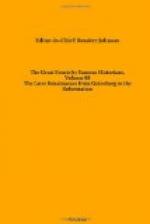Although Henry VIII had recently completed his breach with Rome and been excommunicated, he alternately punished the religious movements of Protestants and Catholics, according to his caprice; and it was but a few years previously that the reading of the Bible had been prohibited by act of parliament, that men had been burned at the stake for having even fragments of it in their possession, and that Tyndale’s translation of the new Testament had been bought up and publicly burned (1534) by order of Cuthbert Tunstall, Bishop of London; and even as late as May, 1536, the reading of the sacred volume had been strictly forbidden.
Grafton, therefore, must have been a bold man to face the danger. Thus, in 1538, when a new edition of the Bible, commonly called the “Great Bible,” afterward published in 1539, was secretly printing in Paris at the instance of Lord Cromwell, under the superintendence of Grafton, Whitchurch, and Coverdale, the French inquisitors of the faith interfered, charging them with heresy, and they were fortunate in making their escape to England.
Shortly after the death of Caxton’s patron, Lord Cromwell, Grafton was imprisoned for the double offence of printing Matthew’s Bible and the Great Bible, notwithstanding the King’s license; and though after a while released, he was again imprisoned in the reign of Philip and Mary on account of his Protestant principles; and, after all his services to religion and literature, died in poverty in 1572.
Printing was now spreading all over England. It had already begun at Oxford in 1478—some say earlier—at Cambridge soon after, although the first dated work is 1521; at St. Albans in 1480; York in 1509; and other places by degrees.
Printing did not reach Scotland till 1507, and then but imperfectly, and Ireland not till 1551, owing, it is said, to the jealousy with which it was regarded by the priesthood.
We will now take a rapid survey of the vast strides printing has made of late years in England, and therewith close. The principal movements have been in stereotyping, electrotyping, the improvement of presses, and the application of steam power. Stereotyping is the transfer of pages of movable type into solid metal plates, by the medium of moulds formed of plaster of Paris, papier-mache, gutta-percha, or other substances. This art is supposed to have been invented, in or about 1725, by William Ged, a goldsmith of Edinburgh. A small capitalist, who had engaged to embark with him, withdrawing from the speculation in alarm, he accepted overtures from a Mr. William Fenner, and in 1729 came to London. Here he obtained three partners, in conjunction with whom he entered into a contract with the University of Cambridge for stereotyping Bibles and prayer-books. But the workmen, fearing that stereotyping would eventually ruin their trade, purposely made errors, and, when their masters were absent, battered the type, so that the only two prayer-books completed were suppressed




